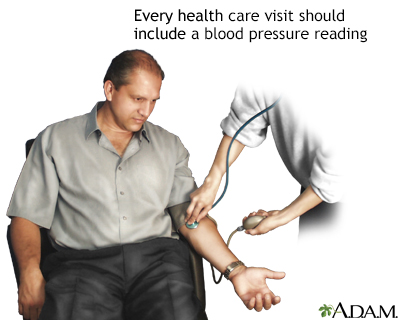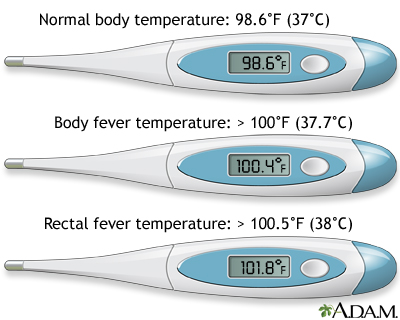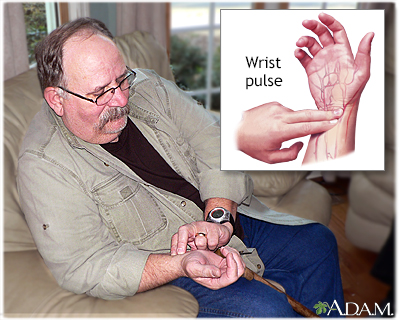Vital signs
Vital signs reflect essential body functions, including your heartbeat, breathing rate, temperature, and blood pressure. Your health care provider may measure, or monitor your vital signs to check your level of physical functioning.
Normal vital signs change with age, sex, weight, exercise capability, and overall health.
Normal vital sign ranges for the average healthy adult while resting are:
- Blood pressure: between 90/60 mmHg and 120/80 mmHg
- Breathing: 12 to 18 breaths per minute
- Pulse: 60 to 100 beats per minute
- Temperature: 97.8°F to 99.1°F (36.5°C to 37.3°C); average 98.6°F (37°C)

To measure blood pressure, your doctor uses an instrument call a sphygmomanometer, which is more often referred to as a blood pressure cuff. The cuff is wrapped around your upper arm and inflated to stop the flow of blood in your artery. As the cuff is slowly deflated, your doctor uses a stethoscope to listen to the blood pumping through the artery. These pumping sounds register on a gauge attached to the cuff. The first pumping sound your doctor hears is recorded as the systolic pressure, and the last sound is the diastolic pressure.

Fever is an important part of the body's defense against infection. Most bacteria and viruses that cause infections in humans thrive best at 98.6 degrees F (37 degrees C). Raising the body temperature a few degrees can help the body fight the infection. In addition, a fever activates the body's immune system to make more white blood cells, antibodies, and other infection-fighting agents.

How to take your pulse. 1. Place the tips of your index and middle finger on the inside of your wrist below the base of your thumb. 2. Press lightly. You will feel the blood pulsing beneath your fingers. 3. Use a watch or clock with a second hand. Count the beats you feel for 1 minute. Or count the beats for 30 seconds and multiply by 2. This is also called your pulse rate.
References
Ball JW, Dains JE, Flynn JA, Solomon BS, Stewart RW. Vital signs and pain assessment. In: Ball JW, Dains JE, Flynn JA, Solomon BS, Stewart RW, eds. Seidel's Guide to Physical Examination. 10th ed. St Louis, MO: Elsevier; 2023:chap 6.
Simel DL. Approach to the patient: history and physical examination. In: Goldman L, Schafer AI, eds. Goldman-Cecil Medicine. 26th ed. Philadelphia, PA: Elsevier; 2020:chap 6.
Version Info
Last reviewed on: 2/2/2023
Reviewed by: Linda J. Vorvick, MD, Clinical Professor, Department of Family Medicine, UW Medicine, School of Medicine, University of Washington, Seattle, WA. Also reviewed by David C. Dugdale, MD, Medical Director, Brenda Conaway, Editorial Director, and the A.D.A.M. Editorial team.
